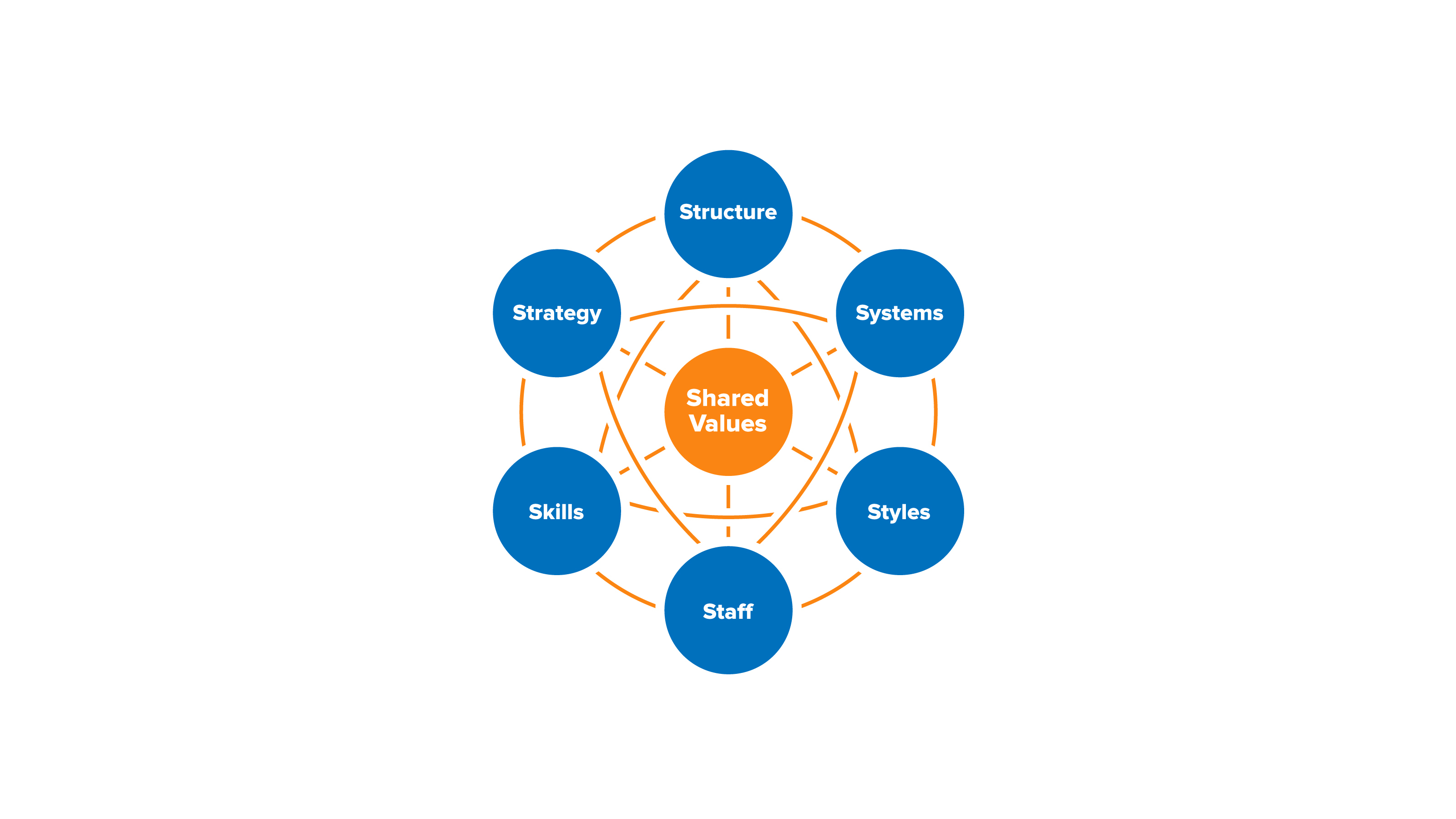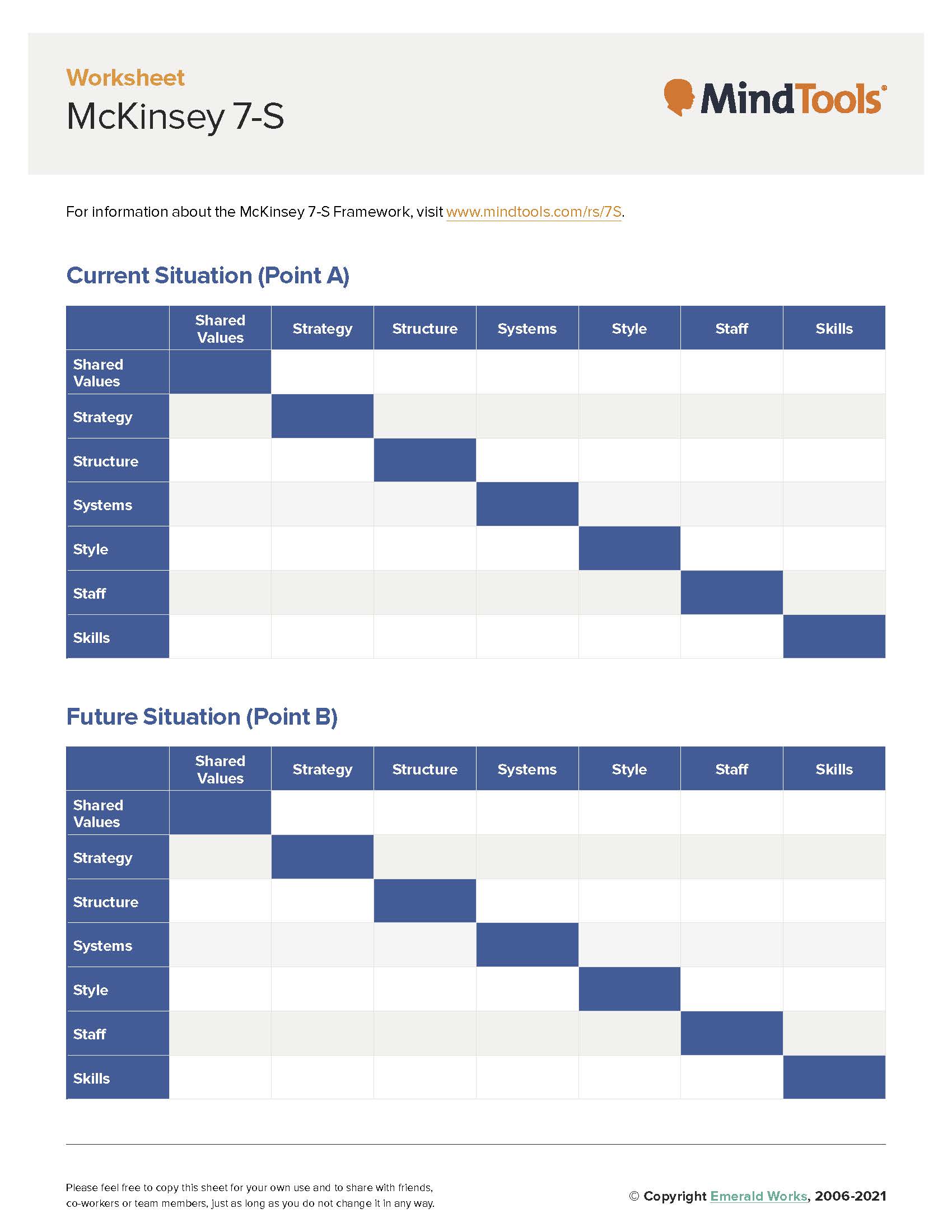McKinsey 7-S Framework
Making Every Part of Your Organization Work in Harmony
Do you know how well your organization is positioned to achieve its goals? Or what elements influence its ability to implement change successfully?
Models of organizational effectiveness go in and out of fashion, but the McKinsey 7-S framework has stood the test of time.
The model was developed in the late 1970s by Tom Peters and Robert Waterman, former consultants at McKinsey & Company. They identified seven internal elements of an organization that need to align for it to be successful. [1]
Do you know the seven key elements of your organization?
In this article, we'll explore the seven elements in detail, and learn how it can be used to improve performance or manage change in organizations by ensuring that they all work in harmony.
Also, we provide a worked example and a downloadable template that you can use to apply the model.
When to Use the McKinsey 7-S Model
You can use the 7-S model in a wide variety of situations where it's useful to examine how the various parts of your organization work together.
For example, it can help you to improve the performance of your organization, or to determine the best way to implement a proposed strategy.
The framework can be used to examine the likely effects of future changes in the organization, or to align departments and processes during a merger or acquisition. You can also apply the McKinsey 7-S model to elements of a team or a project.
The Seven Elements of the McKinsey 7-S Framework
The model categorizes the seven elements as either "hard" or "soft":
| Hard Elements | Soft Elements |
|---|---|
|
Strategy Structure Systems |
Shared Values Skills Style Staff |
The three "hard" elements include:
- Strategy.
- Structures (such as organization charts and reporting lines).
- Systems (such as formal processes and IT systems.)
These elements are relatively easy to identify, and management can influence them directly.
The four "soft" elements, on the other hand, can be harder to describe, and are less tangible, and more influenced by your company culture. But they're just as important as the hard elements if the organization is going to be successful.
Figure 1, below, shows how the elements depend on each other, and how a change in one affects all the others.
Let's look at each of the elements individually:
- Strategy: this is your organization's plan for building and maintaining a competitive advantage over its competitors.
- Structure: this is how your company is organized (how departments and teams are structured, including who reports to whom).
- Systems: the daily activities and procedures that staff use to get the job done.
- Shared Values: these are the core values of the organization and reflect its general work ethic. They were called "superordinate goals" when the model was first developed.
- Style: the style of leadership adopted.
- Staff: the employees and their general capabilities.
- Skills: the actual skills and competencies of the organization's employees.
The placement of Shared Values in the center of the model emphasizes that they are central to the development of all the other critical elements.
The model states that the seven elements need to balance and reinforce each other for an organization to perform well.
Using the McKinsey 7-S Model
You can use the model to identify which elements of the 7-S' you need to realign to improve performance, or to maintain alignment and performance during other changes. These changes could include restructuring, new processes, an organizational merger, new systems, and a change of leadership.
To apply the McKinsey 7-S Model in your organization, follow these steps:
- Start with your shared values: are they consistent with your structure, strategy, and systems? If not, what needs to change?
- Then look at the hard elements – your strategy, structure and systems. How well does each one support the others? Identify where changes need to be made.
- Next, look at the soft elements – shared values, skills, (leadership) style, and staff. Do they support the desired hard elements? Do they support one another? If not, what needs to change?
- As you adjust and align the elements, you'll need to use an iterative (and often time-consuming) process of making adjustments, and then re-analyzing how that impacts other elements and their alignment. The end result of better performance will be worth it.
Figure 2 shows a template matrix that you can use to help with your analysis. You can click on the image to download it as a PDF worksheet.
We've also developed a checklist of the right questions to ask, which you can find in the next section. Supplement the questions in our checklist with your own questions, based on your organization's specific circumstances and your own knowledge and experience.
You can use the 7-S model to help analyze your current situation (Point A in the worksheet), your proposed future situation (Point B in the worksheet), and to identify gaps and inconsistencies between them.
To examine where you are now (Point A), use the data that you've learned from your checklist questions to fill in the worksheet grid, putting a tick in any box where the two cross-referenced elements work together well. If the two elements aren't working well together, put a cross.
Point B is an agreed endpoint in the future (in six months or a year, for example). When you reach Point B, revisit the worksheet and fill it in again. If your changes have worked, you'll have a grid full of ticks. If not, you may need to make further adjustments.
Tip:
The 7-S model is a good framework to help you ask the right questions, but it won't give you all the answers. For that, you'll need to bring together the right people with the right knowledge, skills and experience. Our article, Setting up a Cross-Functional Team, can help you to do this.
Checklist Questions for the McKinsey 7-S Framework
The following questions are a starting point for exploring your situation in terms of the 7-S framework. Use them to analyze your current situation (Point A) first, and then repeat the exercise for your proposed situation (Point B).
Strategy:
- What is our strategy?
- How do we intend to achieve our objectives?
- How do we deal with competitive pressure?
- How are changes in customer demands dealt with?
- How is strategy adjusted for environmental issues?
Structure:
- How is the company/team divided?
- What is the hierarchy?
- How do the various departments coordinate activities?
- How do the team members organize and align themselves?
- Is decision-making centralized or decentralized? Is this as it should be, given what we're doing?
- Where are the lines of communication? Explicit or implicit?
Systems:
- What are the main systems that run the organization? Consider financial and HR systems, as well as communications and document storage.
- Where are the controls and how are they monitored and evaluated?
- What internal rules and processes does the team use to keep on track?
Shared Values:
- What are your organization's core values?
- What is its corporate/team culture like?
- How strong are the values?
- What are the fundamental values that the company/team was built on?
Style:
- How participative is the management/leadership style?
- How effective is that leadership?
- Do employees/team members tend to be competitive or cooperative?
- Are there real teams functioning within the organization or are they just nominal groups?
Staff:
- What positions or specializations are represented within the team?
- What positions need to be filled?
- Are there gaps in required competencies?
Skills:
- What are the strongest skills represented within the company/team?
- Are there any skills gaps?
- What is the company/team known for doing well?
- Do the current employees/team members have the ability to do the job?
- How are skills monitored and assessed?
Example: The McKinsey 7-S Framework in Action
Whitehawk Electronics is a startup with five staff. As a new venture, it is still based firmly on the vision and values of its founder, Alix, and its elements all align. It sells into one market, and uses off-the-shelf IT and accounting systems.
As time goes on, the business grows, employing 30 staff, and diversifying into different markets. New customer requirements demand new skills in marketing, technology, product development, and financial management.
Alix carries out a 7-S analysis. She finds that Whitehawk's developing sales strategy no longer aligns with its small-business skill set.
The rapid influx of new staff members, along with changes in technology, means that some staff don't have the necessary systems skills. Worse still, they're unclear on the organization's values and sense of purpose.
Alix uses the analysis to introduce onboarding and learning programs, bringing all Whitehawk's key elements back into alignment.
Tip:
For other, similar approaches, see our articles on the Burke-Litwin Change Model, and the Congruence Model. You may also find our articles on the Change Curve, Impact Analysis and Lewin's Change Management Model useful.
Key Points
You can apply the McKinsey 7-S framework to almost any organizational or team effectiveness issue. The 7-S' refer to:
- Strategy.
- Structure.
- Systems.
- Shared values.
- Style.
- Staff.
- Skills.
If something within your organization or team isn't working, chances are there is inconsistency between one or more of these seven elements.
Once you reveal these inconsistencies, you can work to align these elements to make sure they are all contributing to your organization's shared goals and values.
The process of analyzing where you are right now, in terms of these elements, is worthwhile in itself. But for it to be truly effective, you'll also need to determine the desired future state for each factor. This will help you make changes and improve performance so that all seven factors are aligned across your organization.
This site teaches you the skills you need for a happy and successful career; and this is just one of many tools and resources that you'll find here at Mind Tools. Subscribe to our free newsletter, or join the Mind Tools Club and really supercharge your career!








The suggestions available on our site for completing the matrix are the ones found in the article above. However, I did look for other examples elsewhere on the internet and was able to find quite a lot of resources. Not sure if you will find what you're looking for, but that's the best advice I have for you for now.
Thanks for the question, and enjoy the site!
BillT
Mind Tools Team
Thanks for your comment. I personally think that there are so many individual variables that is unique to different companies and might influence the outcome. It is therefore hard to give one answer.
If you would like to discuss this further, why not join the Mind Tools Club and bring the question into the Forums to see what other members have to say. More details about membership can be found here: https://www.mindtools.com/junepromo2020?utm_source=hp
Midgie
Mind Tools Team